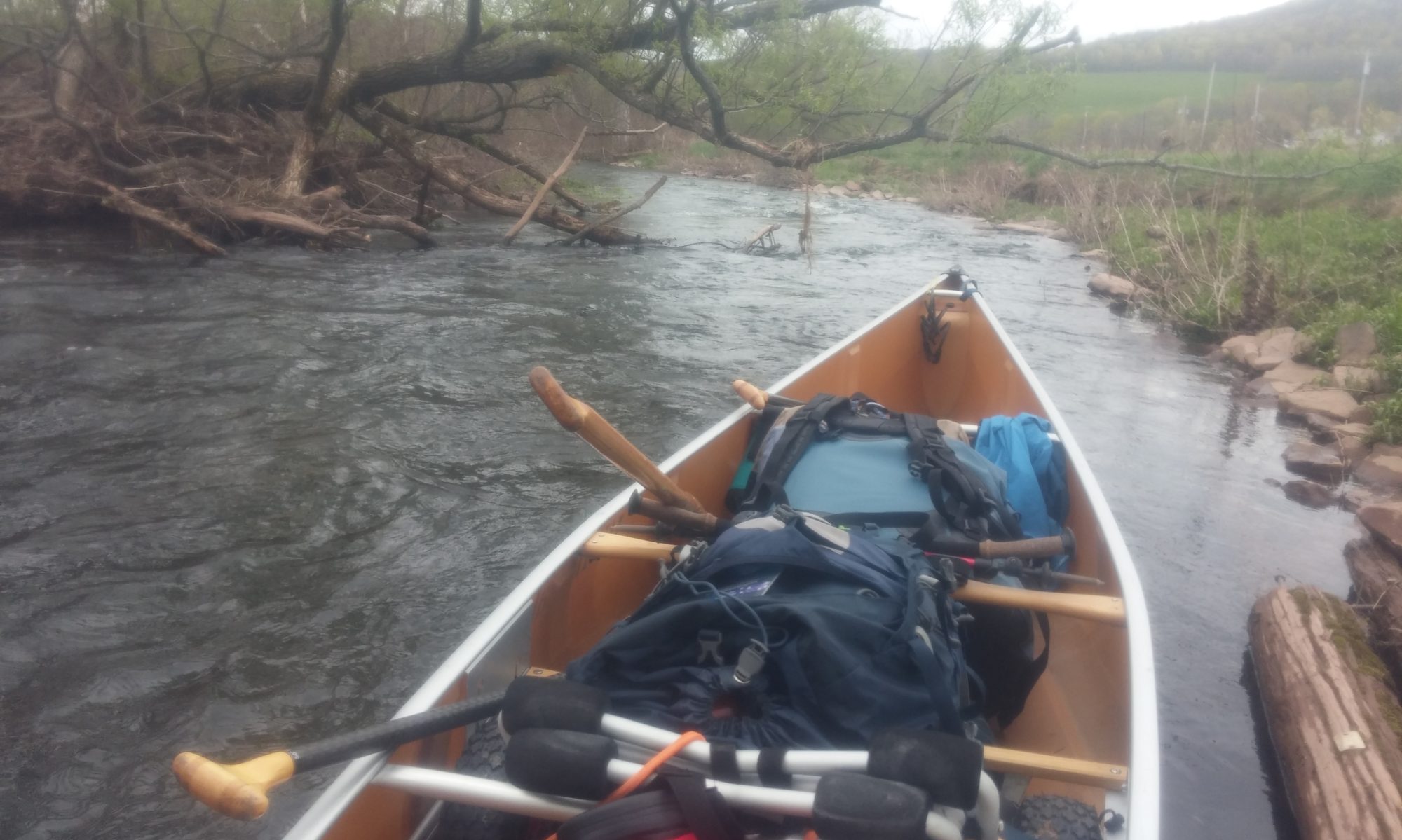Full sun and warm temperatures (maybe 40 degrees, so “warm” is relative) and we packed the gear, donned the dry suits, marveled at how much snow had melted out from around the tent, and shoved off just ever-so-slightly on the Canadian side of the aquatic border. Getting in the water took some doing and a lot of poking with a couple of sturdy sticks, and then we had to break through the ice block. It was almost entirely slush, so I hacked at it with my paddle, we reversed, we plowed in at full speed, repeat… and a few minutes later, we were on the way.
The Northwest Branch of the St John has a pretty good current this time of year, and since we don’t really know anything about the river save what we could parse out from Google Earth and the topo maps (i.e. not very much at all), we scooted from eddy to eddy trying to gauge each bend and riffle as best we could before committing.
We made it through two sets of small rapids within the first mile or two, probably a class I+ or II, with some good-sized standing waves and bigass MF-ing rocks. The spray deck performed admirably, and I was glad to be in a drysuit from the first wave. Both of us were absolutely ecstatic to be on the water and finally underway.
Then we heard water- BIG water. It was around a sharp curve to the right, so we couldn’t get a great look beyond one obvious VERY big rock on the inside of the curve, and since there was nowhere to pull out we made the call to hold left of center and run it.
…This was maybe not the best call.
As we rounded the bend, we plowed into what was easily a III+ rapid and would probably have been a solid IV if it had been longer. The river dropped about ten feet over the course of 20 yards between several HUGE boulders.

The stupidest part was that we came so damn close to making it through without even getting any water in the boat because it was such a short stretch. We easily cleared the first big rocks, bounced through the first two or three massive standing waves… and then clipped something.
Neither of us saw what it was, but either way the boat went out from under me so fast I barely had enough time to reflect on my life choices before it shoved me underwater. I popped back up, skidded off a rock, and within seconds both of us were swimming the upside-down boat to shore with paddles in hand.
It’s worth noting that Steve’s stupid captain’s hat both stayed on his head AND remained dry.
We coasted into an eddy and flipped the boat back over to assess the damage. Thanks to the spray deck, we only lost a loose Nalgene and a stuff sack of tie downs (my bad- it floated past me in the eddy and I failed to grab it before it sank because like a complete moron I reached for our giant bailing sponge first)… but the very tip of the bow was smashed to hell. It wasn’t anything bad enough to compromise the structural integrity of the boat; the protective end cap had been sheared off and while the float tank was no longer watertight, all the damage was well above the waterline. While it’ll probably be an easy repair once we’re back in civilization, it was pretty sobering and it completely soured Steve’s mood for the rest of the day
He did, however, find the “silver lining” to my rubber boot (which I lost while using it as a bailer) and waded back upriver to get some good photos of the rapid that dented his baby.

Shaken but righted, we got back in and made it about another half mile before we heard more big water. This time we managed to pull over; good thing, too. Fast water and more class III rapids awaited, complete with ice chunks sailing through as the lake behind us cleared out, and more of the same visible down the line at the next bend.
Portage it is! …Through a hellish mix of small scrubby evergreens, downed trees, and thigh-deep snow. It took us all afternoon to get the boat about 200 yards, which was the point when it started to rain and we figured screw it: we’re on the highest ground around and we can already say we probably can’t run the next batch of rapids.

We hung a couple lines, tromped out a place for the tent, and just barely got set up and under cover before it started coming down in earnest.
We’re FINALLY paddling… even if we only made it about three miles. So much for the “easy handful of miles” we were hoping for before the confluence. It looks like we’ll probably spend all day tomorrow portaging.
I feel like I need to give Steve some time alone with the canoe. And the scotch. 🙁













